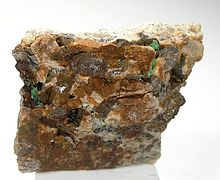Miarole

Bazzite (blue), grown into granite from the Gjaidtroghöhe , Fleißtal , Carinthia, Austria (size: 8.7 cm × 4.9 cm × 3.6 cm)
As miarolitic cavity or miarolitischer cavity small, bubble-like cavities in are igneous rocks such as, among others, granite and pegmatite referred.
description
These miarolitic cavities are formed by volatile gases that escape from the magma during the cooling phase . Since the cooling progresses faster on their surface, the edge zones of granite or pegmatite bodies in particular consist of a miarolitic structure. Mostly well-developed and idiomorphic minerals are found as drusen filling in the miaroles.
The word origin is in the Italian miarolo and describes a locally occurring granite variety with cavities near Baveno on the west bank of Lake Maggiore , which was also called Miarolit .
literature
- Hans Murawski, Wilhelm Meyer: Geological dictionary . 12th edition. Spektrum Akademischer Verlag, Heidelberg 2010, ISBN 978-3-8274-1810-4 , pp. 108 .
Individual evidence
- ^ Ferdinand Senft: Synopsis of Mineralogy and Geognosy . Hahn'sche Buchhandlung, Hanover 1876, p. 473 ( limited preview in Google Book search).
